Grant Banbury – 24 September, 2020
Although primarily known as a print-maker working in woodblock, monoprint, collograph and embossing, with imagery sourced from her Chinese and Pākehā whakapapa, here Lowe shifts tack. The exhibition is reduced to variations of black ink on hand-made paper. Her ‘brush and ink studies' (the artist's term) offer an openness, a lightness of touch only hinted at to date. Lowe's strategy is intuitive, a sort of ‘letting go'.
The Silence of the Brush feels an appropriate title for Kim Lowe‘s recent outing, her second exhibition in Ōtautahi Christchurch in quick succession. (The first, If Tao is a River, opened at Chambers Art Gallery in June.) Lowe is the recipient of the 2019 Olivia Spencer Bower Foundation Art Award, now in its 33rd year and one of only two year-long visual art awards in the country.
Although primarily known as a print-maker working in woodblock, monoprint, collograph and embossing, with imagery sourced from her Chinese and Pākehā whakapapa, here Lowe shifts tack. The exhibition is reduced to variations of black ink on hand-made paper. Her Brush and Ink Studies (the artist’s term) offer an openness, a lightness of touch only hinted at to date. Lowe’s strategy is intuitive, a sort of ‘letting go’. Crafting tonal variants of greys through to dense blacks—with only the occasional addition of acrylic wash—the results are exploratory, and playful. Initially the works feel tentative, resembling pages extracted from a workbook: mellow, contemplative, nothing forced—a ‘slow-burn.’
The words Silence of the Brush, hint at the artist’s Chinese heritage and in particular the ancient traditions of Chinese brush painting and calligraphy. Works hangs from tiny bulldog clips, allowing each the freedom to float freely. In a presentation that favours process-privileging studio practice and informality over gallery exhibition, the installation questions perceptions as to what constitutes a finished artwork.
Lowe’s show brims with marks—rhythmical, oppositional, transparent or dense—delivered from a range of soft, long-haired Chinese brushes, as well as those of a more conventional nature. The fact that the accompanying catalogue includes a colour photograph of brushes reinforces their significance. Referencing nature, plant forms, reeds, water and wetlands and perhaps most importantly, time and movement, Lowe’s work recalls aspects of Olivia Spencer Bower‘s own approach to watercolour and, at times, subject too. The sweeping brush-strokes, wet-on-wet or dry, and so much part of Spencer Bower’s landscape vision, are assimilated here.
A grid of 41 small studies on mulberry and harakeke (flax) papers, set in rows stretching the length of one wall—although understated—carries the exhibition, lending a feeling of intimacy and immediacy. As you walk along, reading from work to work, the mass of brushed gestures (marks) unfold like musical notes. The longer you look, the more rewarding this becomes. Intimate in scale, apart from one large work (135 x 277cm), the show feels diaristic, meditative.
Inside the gallery, near the door, viewers are greeted with a tall plinth topped with brushes, ink, water, ink stone (plus hand sanitiser, now a regular in our Covid-19 world). A sign on the wall reads: ‘Four Treasures — Please Sign in and Wash your Hands‘, accompanied by further directives including ‘write a short poem, some verse, or make a small tag‘. Over the course of the exhibition a large blank sheet of Fabriano 300gsm paper (140 cm in length) on a nearby table became packed with names, notations, scribbles, brief comments about the exhibition, text and poetry. Known for her community-based workshop in the eastern suburb of New Brighton, Four Treasures continues Lowe‘s belief of the importance of connection and participation.
Through her practice Kim Lowe not only explores her Chinese family’s diasporic history in Aotearoa New Zealand, but also dialogue. Her work looks both back and forward: to a rich ancestry and contemporary understanding of mixed heritage and cultural knowledge. The contemplative nature of The Silence of the Brush rewards with close attention.
Grant Banbury

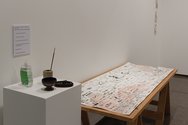
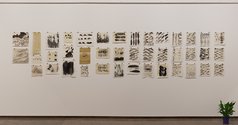
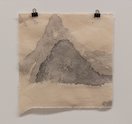

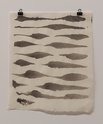

 Advertising in this column
Advertising in this column Two Rooms presents a program of residencies and projects
Two Rooms presents a program of residencies and projects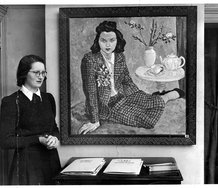
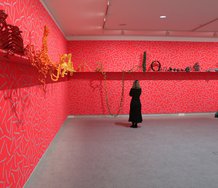
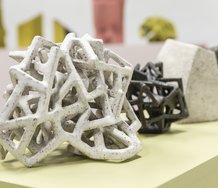
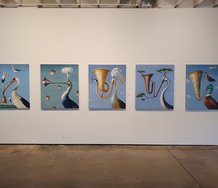
This Discussion has 2 comments.
Comment
Kim Lowe, 8:23 p.m. 9 December, 2020 #
The title probably shouldn't have been called Contemporary Chinese Calligraphy seeing as there isn't any Chinese in the work (other than the comments my Asian friends made in the interactive work).
Maybe Contemporary Hainamana Calligraphy?
Kim Lowe, 9:33 p.m. 14 December, 2020 #
Thank you. I like the new title.
Participate
Register to Participate.
Sign in
Sign in to an existing account.